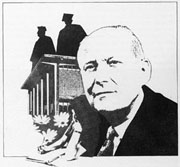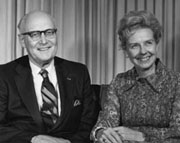Wood Presidency Draws to a Close

This article appeared in the February, 1981 issue of Now in the North.
As Dr. William Ransom Wood prepares to step down from the presidency of the University
of Alaska, he has just one regret: "Time runs out too fast."
"At some point you come to realize how brief a time you've got to accomplish all the
things you can conceive, and finally you come to the full realization you're not going
to get all of them done," said the educator.
Dr. Wood, fourth president of the state university, after Charles E. Bunnell, Terris
Moore, and Ernest N. Patty, has guided the institution for 13 years. Since he assumed
office on July 1, 1960, the university has undergone unprecedented growth and development,
made possible by statehood and strong public support.
 In 1960, the university consisted of the original main campus at Fairbanks and four
community colleges. Since then, major campuses have been developed in Anchorage and
Juneau, the number of community colleges has grown to eight, 20 extension and public
service centers have been established, and research facilities have proliferated on
the Fairbanks campus, greatly enhancing the university's national and international
reputation as a center for research and advanced study.
In 1960, the university consisted of the original main campus at Fairbanks and four
community colleges. Since then, major campuses have been developed in Anchorage and
Juneau, the number of community colleges has grown to eight, 20 extension and public
service centers have been established, and research facilities have proliferated on
the Fairbanks campus, greatly enhancing the university's national and international
reputation as a center for research and advanced study.
This development was part of a plan adopted by the Board of Regents in 1964 to decentralize
the university and to take education to the people. A single campus could not meet
the needs of the vast state.
The growth of a university is measured in more than buildings. In 1960, the Alaska
institution's total full-time enrollment was 921 students. Nearly that number will
be receiving degrees from it this year. More than 10,000 students were enrolled in
academic programs last fall.
It is estimated that nearly 30,000 Alaskans—some 10 per cent of the 49th State's population—have
some direct instructional contact with their university each year.
"Each time I reflect on the progress of the University of Alaska during its relatively
brief history, I am overwhelmed by the tremendous job the people of the state have
done for themselves," said Dr. Wood.
One of his great satisfactions is the support the voters have given the university.
All the bond issues for university construction that have gone on the ballot since
statehood have been overwhelmingly approved.
Other satisfactions have been our success in attracting some "extraordinary professional
talent to the university" and the "very fine relationship I've enjoyed with the university's
Board of Regents." The regents, he said, "have been very hard taskmasters at times
but they have always been fair and have supported good effort."
Peering at the university's future, Dr. Wood sees it as "excellent in the long range
but close to the traumatic in the short range." So in the near future "we're simply
going to have to curb development to fit the availability of funds," which means that
"a great many educational demands—legitimate requests that come from the people for
educational opportunity and services—will not be met."
The educator adds: "Once Alaska if, permitted to develop its resources, it is in an
extraordinarily advantageous position, for it has resources far in excess of population.
And if the rate of development of these resources can proceed in advance of the rate
of population growth, we have a very, very healthy future ahead of us."
When Dr. Wood steps down from the presidency on June 30, he will have spent 45 years
in education. He has been a public school teacher and coach, public school administrator,
university teacher and community college director. He has served in the U.S. Office
of Education as a specialist in higher education planning. He was a University of
Nevada vice president from 1954-60 and in his last two years at that institution was
also director of its Desert Research Institute.
A professor of English, he holds B.A., M.A., and Ph.D. degrees. He has an honorary
Doctor of Laws degree from Illinois College, where he did his undergraduate work.
He has been an educational consultant to a number of foreign nations, including South
Vietnam, Wood been honored for his work. He is a poet and author of many publications.
He served with the U.S. Navy during World War I and retired from the U.S. Naval Reserve
in 1970 with the rank of captain.
Dr. Wood is an honorary member of the Pioneers of Alaska and has been elected to the
Forty-Niner Hall of Fame. Students of the university voted to name the new student
union building on the Fairbanks campus for the educator.
UA Site named after Willam Ransom Wood
William Ransom Wood is also mentioned in these articles:
Presidents: 1960-1973 William R Wood
Public Service: An Added Dimension, Fairbanks Flood 1967
UA Honorary Degrees: 1989
